Page 238 of 400
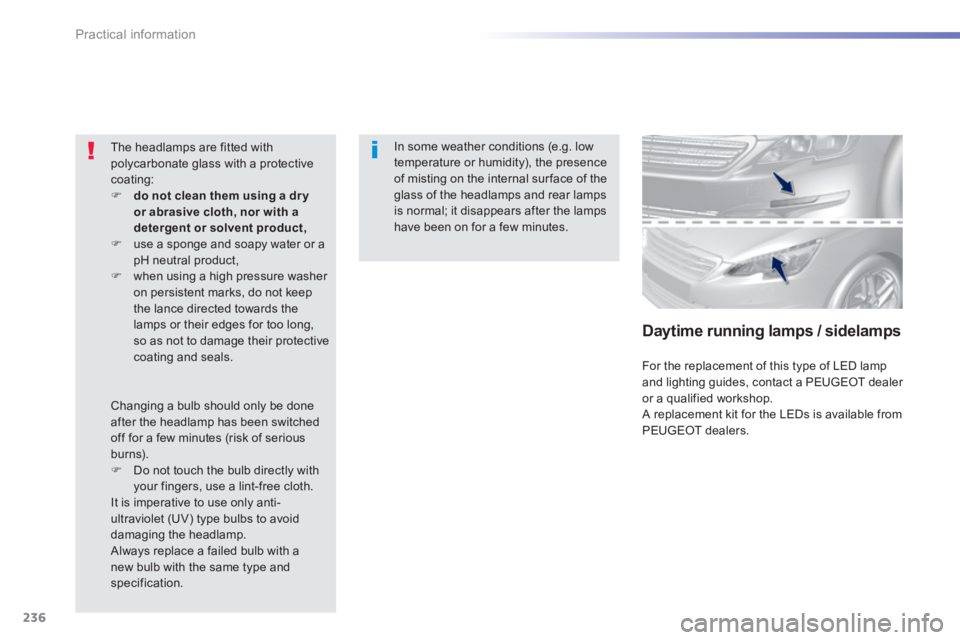
236
Practical information
In some weather conditions (e.g. low temperature or humidity), the presence of misting on the internal sur face of the glass of the headlamps and rear lamps is normal; it disappears after the lamps have been on for a few minutes.
The headlamps are fitted with polycarbonate glass with a protective coating: do not clean them using a dr y or abrasive cloth, nor with a detergent or solvent product, use a sponge and soapy water or a pH neutral product, when using a high pressure washer on persistent marks, do not keep the lance directed towards the lamps or their edges for too long, so as not to damage their protective coating and seals.
Changing a bulb should only be done after the headlamp has been switched off for a few minutes (risk of serious burns). Do not touch the bulb directly with your fingers, use a lint-free cloth. It is imperative to use only anti-ultraviolet (UV) type bulbs to avoid
damaging the headlamp. Always replace a failed bulb with a new bulb with the same type and specification.
Daytime running lamps / sidelamps
For the replacement of this type of LED lamp and lighting guides, contact a PEUGEOT dealer or a qualified workshop. A replacement kit for the LEDs is available from
PEUGEOT dealers.
Page 239 of 400
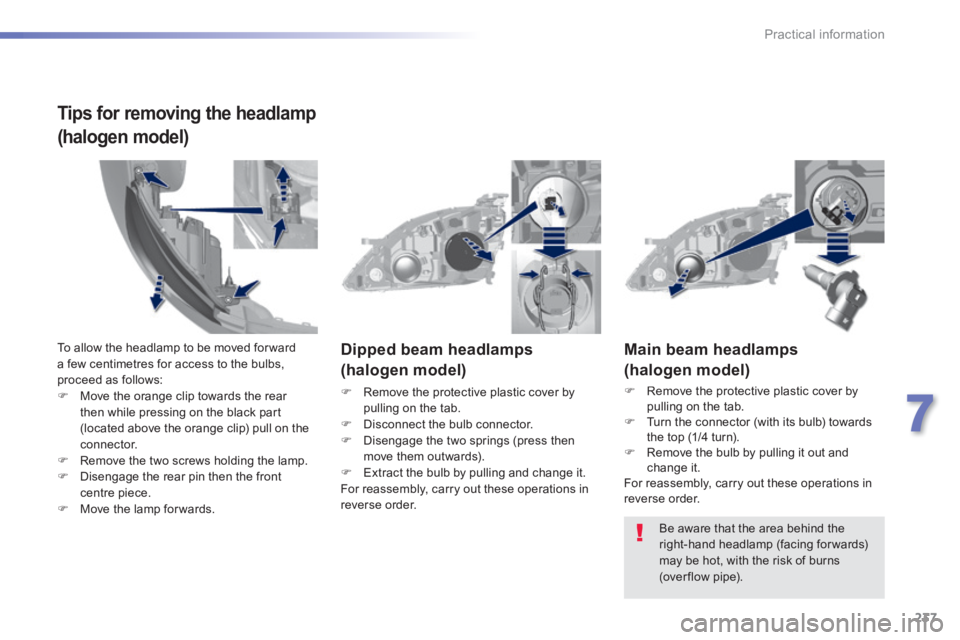
237
7
Practical information
Main beam headlamps
(halogen model)
Remove the protective plastic cover by pulling on the tab. Turn the connector (with its bulb) towards the top (1/4 turn). Remove the bulb by pulling it out and change it. For reassembly, carry out these operations in reverse order.
Dipped beam headlamps
(halogen model)
Remove the protective plastic cover by pulling on the tab. Disconnect the bulb connector. Disengage the two springs (press then move them outwards). Extract the bulb by pulling and change it. For reassembly, carry out these operations in reverse order.
Be aware that the area behind the right-hand headlamp (facing forwards) may be hot, with the risk of burns (over flow pipe).
To allow the headlamp to be moved for ward a few centimetres for access to the bulbs, proceed as follows: Move the orange clip towards the rear then while pressing on the black part (located above the orange clip) pull on the
connector. Remove the two screws holding the lamp. Disengage the rear pin then the front centre piece. Move the lamp for wards.
Tips for removing the headlamp
(halogen model)
Page 259 of 400
257
7
Practical information
Towing the vehicle Procedure for having your vehicle towed or for towing another vehicle using a removable towing eye.
Access to the tools
The towing eye is installed in the boot under the floor. To gain access to it: open the boot, raise the floor, remove the towing eye from the holder.
Put the gear lever into neutral. The failure to follow this requirement may lead to damage to components of the braking system and the lack of braking assistance on restarting the engine.
On the front bumper, press the cover (as shown above) to unclip it. Screw the towing eye in fully. Install the towing bar. Switch on the hazard warning lamps on the towed vehicle. Move off gently and drive slowly over a short distance only.
From the front
Page 260 of 400
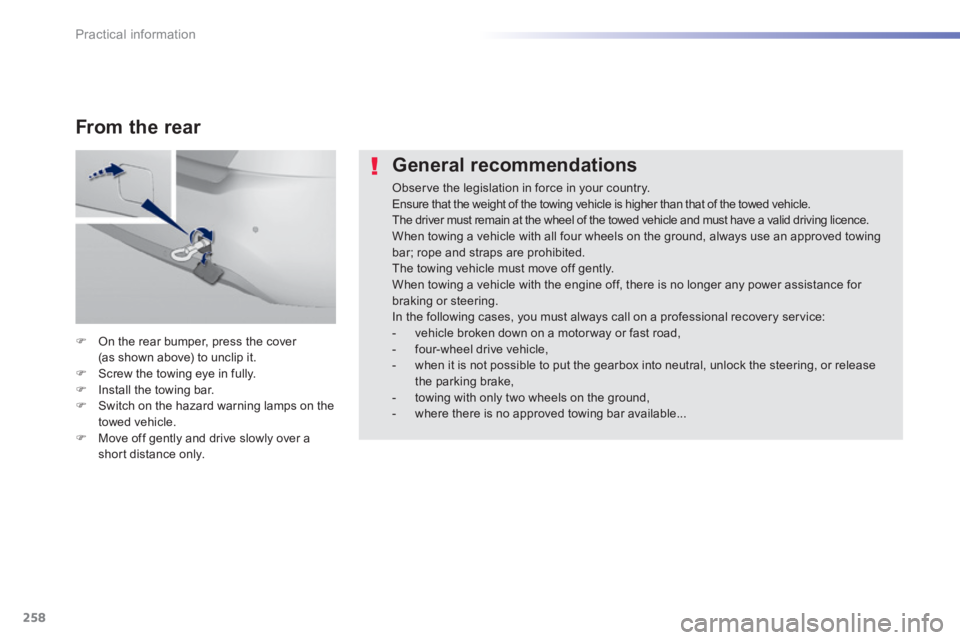
258
Practical information
General recommendations
Observe the legislation in force in your country. Ensure that the weight of the towing vehicle is higher than that of the towed vehicle. The driver must remain at the wheel of the towed vehicle and must have a valid driving licence. When towing a vehicle with all four wheels on the ground, always use an approved towing bar; rope and straps are prohibited. The towing vehicle must move off gently. When towing a vehicle with the engine off, there is no longer any power assistance for braking or steering. In the following cases, you must always call on a professional recovery service: - vehicle broken down on a motor way or fast road, - four-wheel drive vehicle, - when it is not possible to put the gearbox into neutral, unlock the steering, or release the parking brake, - towing with only two wheels on the ground, - where there is no approved towing bar available...
On the rear bumper, press the cover (as shown above) to unclip it. Screw the towing eye in fully. Install the towing bar. Switch on the hazard warning lamps on the towed vehicle. Move off gently and drive slowly over a short distance only.
From the rear
Page 261 of 400
259
7
Practical information
Very cold climate screen
Before fitting or removing the screen, ensure that the engine is off and the cooling fan has stopped. It is recommended that the screen be fitted and removed by a PEUGEOT dealer or a qualified workshop.
Fitting
Offer up the screen to the front of the top section of the front bumper upper grille. Press on the screen to engage its fixing clips.
Removal
Use a screwdriver as a lever to unclip each retaining clip in turn.
Do not forget to remove the very cold climate screen: - when the ambient temperature exceeds 10° C (for example: in summer, ...), - when towing, - at speeds above 75 mph (120 km/h).
Removable protective screen which prevents the accumulation of snow at the radiator cooling fan.
Page 262 of 400
260
Practical information
Towing a trailer
We recommend the use of genuine PEUGEOT towbars and their harnesses that have been tested and approved from the design stage of your vehicle, and that the fitting of the towbar is
entrusted to a PEUGEOT dealer or a qualified workshop. If the towbar is not fitted by a PEUGEOT dealer, it is imperative that it is fitted in accordance with the vehicle manufacturer's instructions. Towbar suitable for the attachment of a trailer or installation of a bicycle carrier, with additional lighting and signalling.
Blanking cover
When towing, you must remove the blanking cover if your vehicle has one. Contact a PEUGEOT dealer or a qualified workshop for this. Driving with a trailer places greater demands on the towing vehicle and the driver must take particular care.
Your vehicle is primarily designed for transporting people and luggage, but it may also be used for towing a trailer.
The cover is located behind the lower air intake grille.
Page 263 of 400
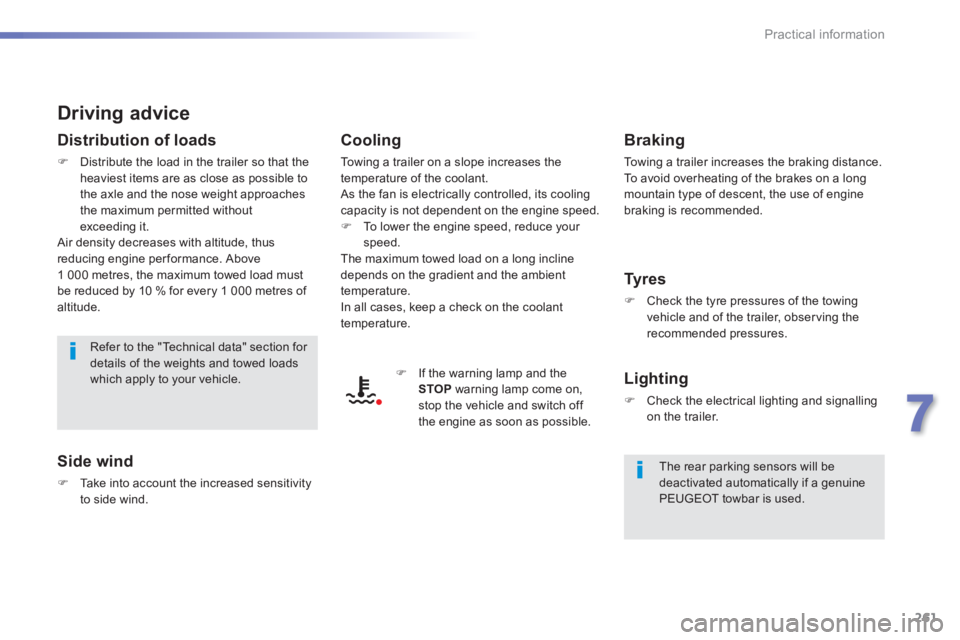
261
7
Practical information
Driving advice
Distribution of loads
Distribute the load in the trailer so that the heaviest items are as close as possible to the axle and the nose weight approaches the maximum permitted without
exceeding it. Air density decreases with altitude, thus reducing engine performance. Above 1 000 metres, the maximum towed load must be reduced by 10 % for every 1 000 metres of altitude.
Side wind
Take into account the increased sensitivity to side wind.
Cooling
Towing a trailer on a slope increases the temperature of the coolant. As the fan is electrically controlled, its cooling capacity is not dependent on the engine speed.
To lower the engine speed, reduce your speed. The maximum towed load on a long incline depends on the gradient and the ambient temperature. In all cases, keep a check on the coolant temperature.
If the warning lamp and the STOP warning lamp come on, stop the vehicle and switch off the engine as soon as possible.
Braking
Towing a trailer increases the braking distance. To avoid overheating of the brakes on a long mountain type of descent, the use of engine braking is recommended.
Ty r e s
Check the tyre pressures of the towing vehicle and of the trailer, observing the recommended pressures.
Lighting
Check the electrical lighting and signalling on the trailer.
The rear parking sensors will be deactivated automatically if a genuine PEUGEOT towbar is used.
Refer to the "Technical data" section for details of the weights and towed loads which apply to your vehicle.
Page 266 of 400
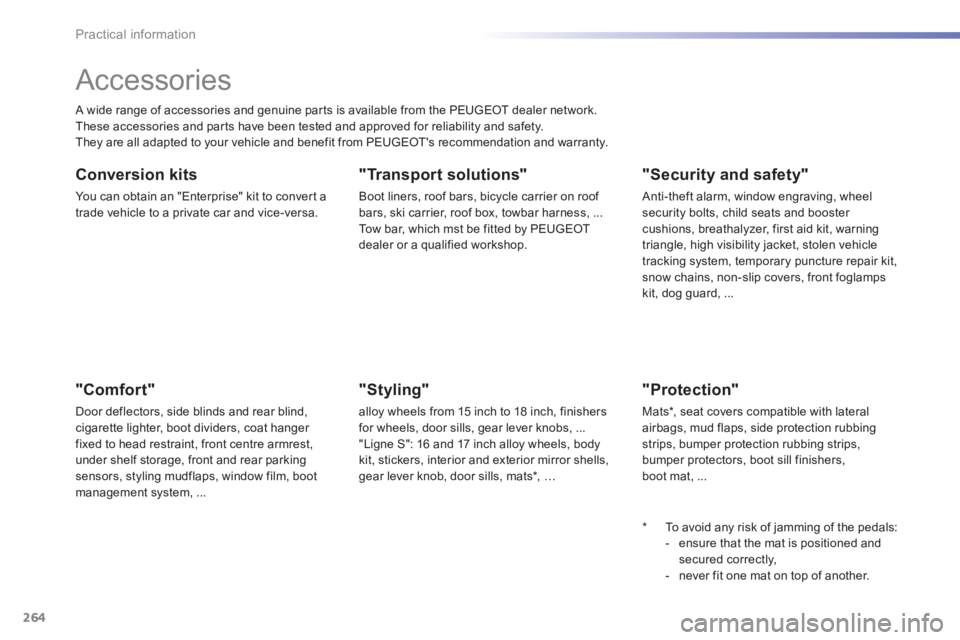
264
Practical information
Accessories
A wide range of accessories and genuine parts is available from the PEUGEOT dealer network. These accessories and parts have been tested and approved for reliability and safety. They are all adapted to your vehicle and benefit from PEUGEOT's recommendation and warranty.
"Comfort"
Door deflectors, side blinds and rear blind, cigarette lighter, boot dividers, coat hanger fixed to head restraint, front centre armrest, under shelf storage, front and rear parking sensors, styling mudflaps, window film, boot management system, ...
"Transport solutions"
Boot liners, roof bars, bicycle carrier on roof bars, ski carrier, roof box, towbar harness, ...
Tow bar, which mst be fitted by PEUGEOT dealer or a qualified workshop.
"Styling"
alloy wheels from 15 inch to 18 inch, finishers for wheels, door sills, gear lever knobs, ... "Ligne S": 16 and 17 inch alloy wheels, body kit, stickers, interior and exterior mirror shells, gear lever knob, door sills, mats * , …
* To avoid any risk of jamming of the pedals: - ensure that the mat is positioned and secured correctly, - never fit one mat on top of another.
"Security and safety"
Anti-theft alarm, window engraving, wheel security bolts, child seats and booster
cushions, breathalyzer, first aid kit, warning triangle, high visibility jacket, stolen vehicle tracking system, temporary puncture repair kit, snow chains, non-slip covers, front foglamps kit, dog guard, ...
"Protection"
Mats * , seat covers compatible with lateral airbags, mud flaps, side protection rubbing strips, bumper protection rubbing strips, bumper protectors, boot sill finishers, boot mat, ...
Conversion kits
You can obtain an "Enterprise" kit to convert a trade vehicle to a private car and vice-versa.